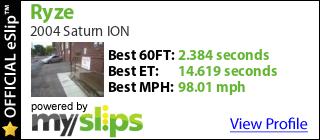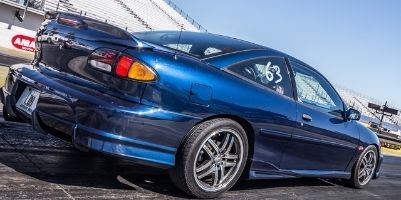New Engine Break in Procedure ??? - Performance Forum
Forum Post / Reply
You must log in before you can post or reply to messages.
Hello...
I was wondering whats the PROPER way to break in an engine that has been rebuilt. Rods, pistons & bearings are all new.
I will definately let it warm up before I drive it hard- but that initial procedure is what I need to know..
Hold it @ a certain RPM for an extended period or time? Change the oil after 10 minutes etc etc..
Please- I don't want people to guess. If you know, please post.
Thanks in advance.

NO don' change the oil after 10 mins.. Try about a couple hundred miles, then a couple hundred more and change it again.
Drive the car normal at around 30-40 mph assuming that is normal driving.. Dont baby it because the seals will not seat correctly, especially if you plan on driving it hard later down the road.
After first driing the car for about 20-30 mins or so bring it back home and check for leaks.. Then go from there if you dont have any.
~2014 New Z under the knife, same heart different body~
______________________
WHITECAVY no more
2012 numbers - 4SPD AUTOMATIC!!
328 HP
306 TQ
Every engine I've ever rebuilt I broke in this way...approximately 23 engines from V-8s to turbo 4 engines. And this is assuming you did a fine hone not a coarse hone.
Let the engine idle so the engine is full operating temps and make sure the cooling system has no leaks. Go to the nearest country road driving normally. If standard, accelerate to the bottom of 3rd if auto lock in it 2nd. WOT the engine to peak power not the redline, then let off completely and engine brake to 1500 RPM, do that about 7 times(this is going to push the piston rings out to form the seal extremely well) , then go back home and change the oil filter(Wal-Mart supertech are the best for this because they are cheap, filter better and flow more oil then frams). After that just drive like normal(oil change at 1k miles). Don't switch to a full synthetic till your 4k mile oil change.
New bearing technologies and better machining of parts means the go easy on it for 500 miles doesn't exist anymore. if it's a coarse hone I wouldn't recommend this break in procedure as you'll find peices of piston ring in your oil pan unless you used moly rings. I can't think of anyone using coarse hone since the 70's tho...
That steady speed breakin you were told is for a roller cam break-in and is the most crucial of break-ins. Whatever you do, don't let the car stay at a steady rpm for an extended period of time(1-2 mins) under load until after you've done the 7 runs.
--------------------------------------------------
'96 Cavalier Good ol' Pushrod 2.2
-24X,000 miles on factory build
-Some oil loss between changes, me thinks it be rings.
i have heard like 6 different ways to break in the motor...
i just let it idle and varied the rpms for 40 mins then changed the oil then drive it for 500 and change the oil again and your fine, but dont go crazy in those 500 miles
 LE61T PTE6262 Powered
LE61T PTE6262 Powered 
Full throttle out the gate!!! LOL, i'm just kidding, but I agree with David jones on the method he posted. The most inportent, and left out piece is to leave it in gear and let it engine brake. People forget that a lot. So, let it engine brake pretty hard. So, from like 5500 back down to 1500. I did that method, and I removed the head at 500 miles, those cylinder walls looked like glass! they were so perfect. I was amazed.

what I was told when I did mine, was start engine up and hold engine at exactly 2000rpm for 20 minutes. Once you have done this, don't let the engine idle for 500 km. Some people believe in altering loads/engine rpm, they didn't suggest it to me, they also didn't dishonor it.
First oil change at 500km, then the next one at regular intervals. With the fine machining and milling process (depending where you have your work done) the engine will be almost fully broken in after the first 20 minutes... and for sure by the 100 km mark.
But this is what I was instructed to do, and did, and works really well for me.
HP Tuners | Garrett T3/T04B | 2.5" Charge Pipes | 2.5" Downpipe | 650 Injectors | HO Manifold | Addco front/rear | Motor Mounts | HKS SSQV | Spec stage 3 | AEM UEGO Wideband | Team Green LSD | FMIC | 2.3 cams | 2.3 oil pump swap | 280WHP | Now ECOTECED

I broke in my current motor with a start up and let idel for about a minute and shut off to look for any sign of trouble or fluid leaks. Then restart and hold to 2,500-3,000rpm for 15 minutes to break in the valve train. A garden hose was used to run water over the radiator to help keep the motor from over heating. Then a oil change to get all the assem lube out to keep the oil filter from clogging up. Then for the first 5 minites i drove around my neighborhood fairly slow and came home again to check for leaks or any other signs of trouble. After that i went out and started beating on it using a check-valve and manifold vacuum to hold the wastegate open limiting the turbo to about 2psi, then did lots of eased into WOT pulls keeping it under 6,000rpm. After 1000 miles on the motor i did another oil change and turned up the boost.
- 93 mph in the 1/8 mile
Member of J-Body Of Michigan.
That was a very good read, bookmarked
thanks for that

That's a good site. I read it a while back when the site was new. And the picture comparing the pistons...That's true. I saw that when a friend of mine replaced his head after we did that break in 6000 miles before. Like stated before it was like glass cylinder walls and the engine looked like brand spanking new! In the slow break-in they tell you to do your less likely to break something from cheap parts used internally in the beginning and it doesn't make the oil ring seal very well so you end up with a dirty combustion chamber from the first 500 miles and oil consumption. That's how you can tell a properly broken-in engine. If it burns oil, even half a quart, between changes it wasn't broken in right.
And on a turbo engine we usually keep the wastegate opened until the breakin is over then boost it like normal makes sure we aren't rich or lean durring the breaking and we tune later. It's just too bad that almost every car out there has been broken in using the old method.
--------------------------------------------------
'96 Cavalier Good ol' Pushrod 2.2
-24X,000 miles on factory build
-Some oil loss between changes, me thinks it be rings.
David Jones wrote:
And on a turbo engine we usually keep the wastegate opened until the breakin is over then boost it like normal makes sure we aren't rich or lean durring the breaking and we tune later. It's just too bad that almost every car out there has been broken in using the old method.
i was just thinking about this? Just leave the wastegate open totally, or would it benefital to run low boost (couple PSI) until the engine is broken in..
i'm building an ecotec, and since i have 2200 right now, and not all the parts to run the ecotec stock, i'm just going to boost it from the get go thats why i ask

I'm actually not sure...I didn't want to put too much force on the rings at breakin with an aluminum block engine because it can make them wear-in out of round but I only got that from breaking in an aluminum block turbo one cylinder engine for my go-kart which I think is the same hardness as aluminum used in automotive engine blocks. On an iron block it doesn't matter.
We mainly do it because since it's the first time we really run the engine it isn't tuned for boost and going excessively lean/rich durring the break-in can ruin an otherwise perfect break-in. Once the rings have cut their pattern into the cylinder walls it's ok to go a little lean/rich while tuning. The first couple of runs is really what cuts the pattern. The ones after that just make sure it's really in and ready to be thrashed for 350,000 miles lol.
--------------------------------------------------
'96 Cavalier Good ol' Pushrod 2.2
-24X,000 miles on factory build
-Some oil loss between changes, me thinks it be rings.
Aluminum blocks still have iron sleved cylinders...
- 93 mph in the 1/8 mile
Member of J-Body Of Michigan.
Skilz10179 wrote:Aluminum blocks still have iron sleved cylinders...
thats what I was thinking, but I couldn't say it as fact.
HP Tuners | Garrett T3/T04B | 2.5" Charge Pipes | 2.5" Downpipe | 650 Injectors | HO Manifold | Addco front/rear | Motor Mounts | HKS SSQV | Spec stage 3 | AEM UEGO Wideband | Team Green LSD | FMIC | 2.3 cams | 2.3 oil pump swap | 280WHP | Now ECOTECED

In that case it doesn't matter if you boost or not in the break-in as long as the tuning is right already i.e. a rebuild of an already turbo tuned engine.
--------------------------------------------------
'96 Cavalier Good ol' Pushrod 2.2
-24X,000 miles on factory build
-Some oil loss between changes, me thinks it be rings.
And what about for those of us that have new cams to break in in addition to piston rings? I've heard many different theories for that as well...

fortune cookie say:
better a delay than a disaster.
Cam break-in consists of varying the engine speed between 1500-2000 rpm for the first 20 minutes. DO THE CAM BREAK IN FIRST. Your not really loading the engine so while yes your not at idle it's not really under load so it's fine. Great way to make sure your cooling system and electrical system all check out too.
--------------------------------------------------
'96 Cavalier Good ol' Pushrod 2.2
-24X,000 miles on factory build
-Some oil loss between changes, me thinks it be rings.
I can't edit so I'll add here.
Do the cam break-in assuming you need one. On a flat tappet type cam breakin is critical because the lifter spins in it's bore and gets it's pattern worn in durring that first few minutes but if it's left idling as on the 2,2 OHV the cam is splash oiled and it won't get the oil it needs to get the lifter spining and it'll ruin the lobe and the lifter.
On a hydraulic roller cam you don't need a break-in because it has wheels that roll on the cam and they don't spin in their bore like the tappet type does. In that case just make sure you got no leaks and a full cooling system then go run her in.
--------------------------------------------------
'96 Cavalier Good ol' Pushrod 2.2
-24X,000 miles on factory build
-Some oil loss between changes, me thinks it be rings.
David Jones wrote:On a hydraulic roller cam you don't need a break-in because it has wheels that roll on the cam and they don't spin in their bore like the tappet type does. In that case just make sure you got no leaks and a full cooling system then go run her in.
This is what I thought
David Jones wrote:That steady speed breakin you were told is for a roller cam break-in and is the most crucial of break-ins.
This is where you had confused me lol

fortune cookie say:
better a delay than a disaster.
sorry...no edit button lol...i think i was in a hurry on that one thinking of both types and roller just hopped out lol.
--------------------------------------------------
'96 Cavalier Good ol' Pushrod 2.2
-24X,000 miles on factory build
-Some oil loss between changes, me thinks it be rings.
David Jones wrote:I can't edit so I'll add here.
Do the cam break-in assuming you need one. On a flat tappet type cam breakin is critical because the lifter spins in it's bore and gets it's pattern worn in durring that first few minutes but if it's left idling as on the 2,2 OHV the cam is splash oiled and it won't get the oil it needs to get the lifter spining and it'll ruin the lobe and the lifter.
On a hydraulic roller cam you don't need a break-in because it has wheels that roll on the cam and they don't spin in their bore like the tappet type does. In that case just make sure you got no leaks and a full cooling system then go run her in.
2.2s are hydraulic roller cams. The lifters don't spin.
sig not found
David Jones wrote:Every engine I've ever rebuilt I broke in this way...approximately 23 engines from V-8s to turbo 4 engines. And this is assuming you did a fine hone not a coarse hone.
Let the engine idle so the engine is full operating temps and make sure the cooling system has no leaks. Go to the nearest country road driving normally. If standard, accelerate to the bottom of 3rd if auto lock in it 2nd. WOT the engine to peak power not the redline, then let off completely and engine brake to 1500 RPM, do that about 7 times(this is going to push the piston rings out to form the seal extremely well) , then go back home and change the oil filter(Wal-Mart supertech are the best for this because they are cheap, filter better and flow more oil then frams). After that just drive like normal(oil change at 1k miles). Don't switch to a full synthetic till your 4k mile oil change.
New bearing technologies and better machining of parts means the go easy on it for 500 miles doesn't exist anymore. if it's a coarse hone I wouldn't recommend this break in procedure as you'll find peices of piston ring in your oil pan unless you used moly rings. I can't think of anyone using coarse hone since the 70's tho...
That steady speed breakin you were told is for a roller cam break-in and is the most crucial of break-ins. Whatever you do, don't let the car stay at a steady rpm for an extended period of time(1-2 mins) under load until after you've done the 7 runs.
The haynes manual tells you to do a break in similar to what he has said, but not WOT, but just accelerate and then allow the engine to break to help seat the rings.
 FU Tuning
FU Tuning
Forum Post / Reply
You must log in before you can post or reply to messages.









